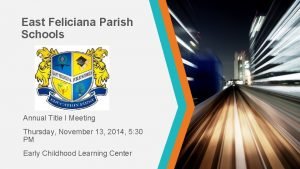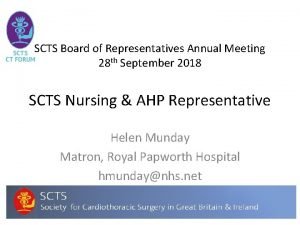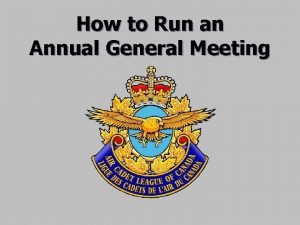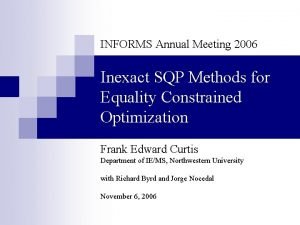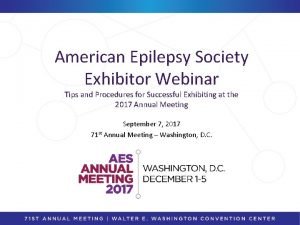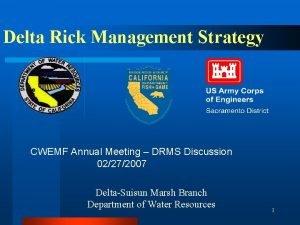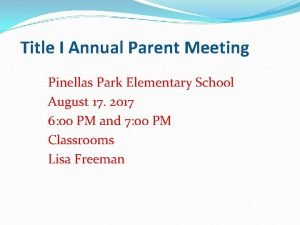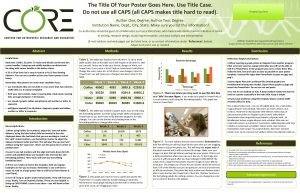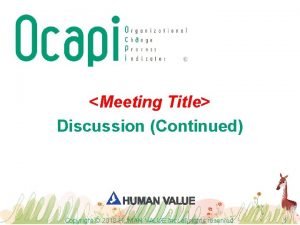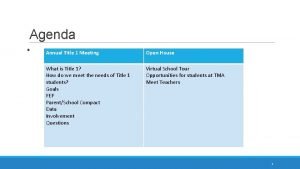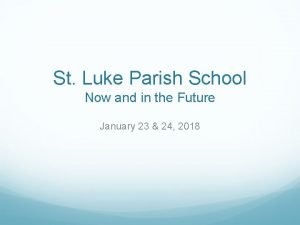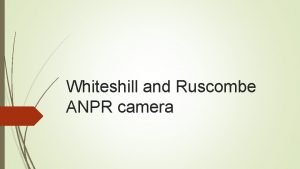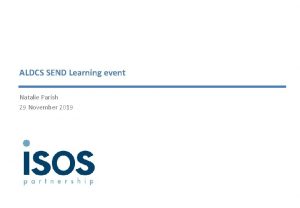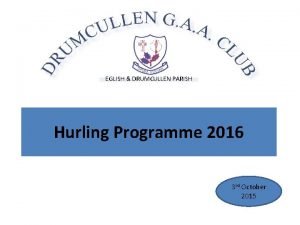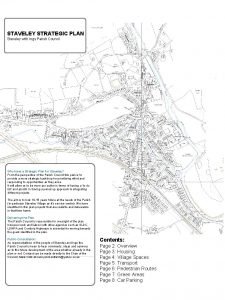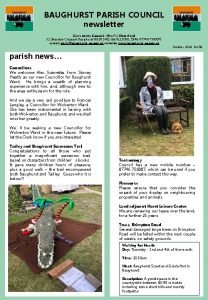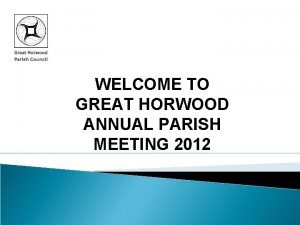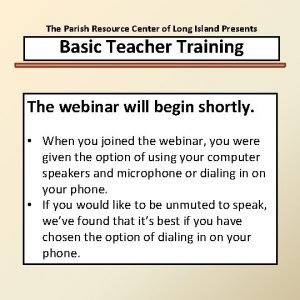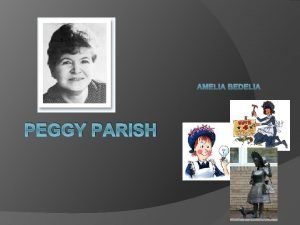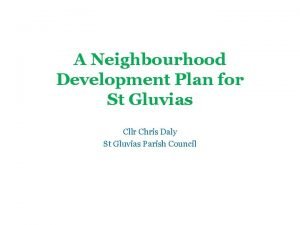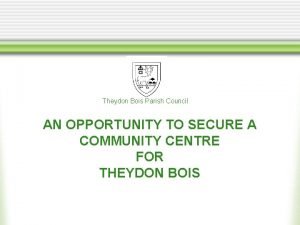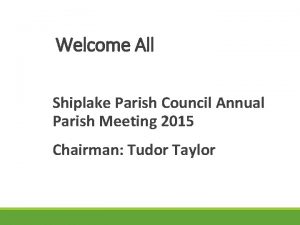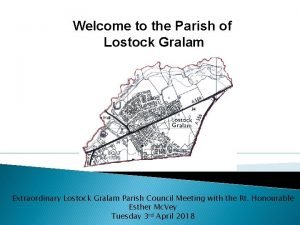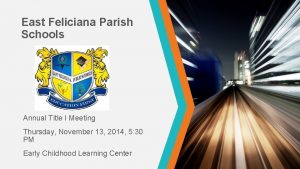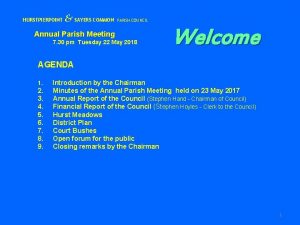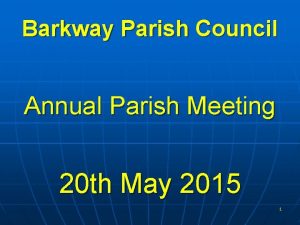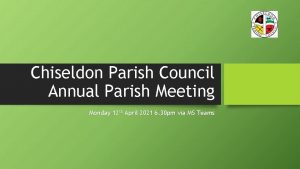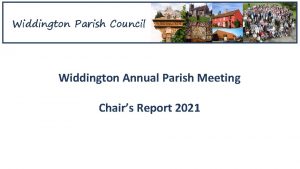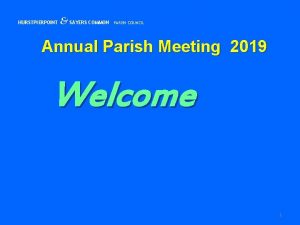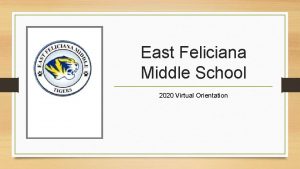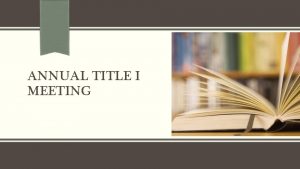East Feliciana Parish Schools Annual Title I Meeting




















































- Slides: 52

East Feliciana Parish Schools Annual Title I Meeting Thursday, November 13, 2014, 5: 30 PM Early Childhood Learning Center

Title I Requirements & Parent Rights Mrs. Edna L. Thomas, Director of School & Community Relations, and Homeless

Title I — Improving The Academic Achievement Of The Disadvantaged What is Title I? Title I, Part A of the Elementary and Secondary Education Act (ESEA) provides financial assistance to states and school districts to meet the needs of educationally at-risk students. The goal of Title I is to provide extra instructional services and activities which support students identified as failing or most at risk of failing the state’s challenging performance standards in mathematics, reading, and writing.

The purpose of Title I is accompanied by… • ensuring that high-quality academic assessments, accountability systems, teacher preparation and training, curriculum, and instructional materials are aligned with challenging State academic standards • meeting the educational needs of low-achieving children • closing the achievement gap between high- and low- performing children • affording parents substantial and meaningful opportunities to participate in the education of their children

Title I Program Requirements • Parental involvement policy & school-parent compact • School Improvement Plan, with the involvement of parents • Highly Qualified Teachers & Paraprofessionals

Title I Parent Rights • In accordance with the No Child Left Behind Act (NCLB), Section 111, (h) (6) PARENTS’ RIGHT TO KNOW, every parent of a student in a Title I school has the right to request and receive information in a timely manner regarding the professional qualifications of your student’s classroom teachers. The information regarding the professional qualifications of your student’s classroom teachers shall include the following: • If the teacher has met state qualification and licensing criteria for the grade level and subject areas taught; • If the teacher is teaching under emergency or temporary status in which the state qualifications and licensing criteria are waived; • The teacher’s baccalaureate degree major, graduate certification, and field of discipline; and • Whether the student is provided services by paraprofessionals, and if so, their qualifications; • In addition to the information above, you will be notified if your student has been taught for four or more consecutive weeks by a teacher that is not highly qualified.

How parents can monitor their student’s progress • Use mygradeportal. com to access the following information • Student grades (9 -weeks grades, individual assignment grades) • Homework assignments, class calendar, teacher website • Revise your personal contact information • Contact your school to obtain your username & password

How parents can work… with educators with their students • Visit and discuss your child’s academic progress regularly with teachers • Discuss academic progress & school events regularly with your child • Volunteer in your child’s classroom, school or related activities • Attend school-sponsored programs • Join & be active in parent/teacher organizations • Supervise completion of homework assignments • Monitor academic progress using “mygradeportal. com” • Teach your child reading, math, science & social studies during everyday activities • Instill proper respect for teachers, principals and other adults

State Assessments Mrs. Latricia Ford-Anderson, District Test Coordinator

Elementary Testing-DSC (Developing Skills Checklist) • This test is given to Pre-K and K students. • The test evaluates the skills that students develop from Pre-K through the end of Kindergarten • It covers language, visual, auditory, mathematical concepts, memory, print, writing, social and emotional, and motor skills • This test helps to determine appropriate instruction for each individual child

TELD-3 • This test is given only to Pre-K students • It is used to help identify students who are experiencing language delays or difficulties • This test is given 2 times a year and 3 times for students who are experiencing difficulties

DIBELS • This test is given to K-3 students. • It is given in the fall, winter, and spring • It monitors the development of early literacy and reading skills • Students may score Benchmark, Strategic, or Intensive on this test • Benchmark-where the student needs to be • Strategic-means the student is at some risk and needs a little help • Intensive-means the student is at high risk of not meeting the end of the year goal

High Stakes Testing- PARCC • Students in Grades 3 -8 will have to take the PARCC Test • The PARCC Test is given in 2 parts. • Phase I of the Test is called the Performance Based Assessment • Phase II is called the End-of-Year Assessment

PARCC Test • The Performance Based Assessment requires students to be able to do the following: • Write effectively when analyzing texts • Answer comprehension and vocabulary questions • Write an essay where they draw evidence from the text • Solve real life Math problems and support the answers with reasoning

PARCC Test – Performance Based Assessment English Language Arts - Grades 3 -8 • Students will have 3 task types that they will have to read and respond to. Those task types are: • Literature Analysis Task- students will have to read 1 short text (200 -400 words - 3 rd- 5 th grade; 400 -600 words – 6 th – 8 th grade) and 1 extended text (400 -800 words – 3 rd – 5 th grade; 600 -1, 000 words – 6 th – 8 th grade) • Research Simulation Task –students will have to read and respond to 2 short texts and 1 extended text • Narrative Writing Task – students will read a short text and write an essay and use evidence from the text in their essay

PARCC Test – Performance Based Assessment English Language Arts - Grades 3 -8 • The Performance Based Assessment has 3 ELA/Literacy sessions. Students will take 1 session a day. The table below shows the session time in minutes. ELA/Literacy Session Times in Minutes Grade(s) PBA Unit 1 PBA Unit 2 PBA Unit 3 (Literary Analysis Task) (Research Simulation Task) (Narratuve Task) 3 rd 75 75 60 75 4 th – 5 th 75 90 60 75 6 th – 8 th 75 90 60 60 EOY Unit 1 EOY Unit 2 60 • PARCC Tests are strictly timed, and no additional time may be permitted, except for students who have a documented extended time accommodation.

Sample Grade 3 Performance Based Assessment Question • The below listed item type will appear at the end of the Performance Based Assessment tasks and asks students to create an extended and complete written response. It elicits evidence that students have understood the texts they have read and can communicate that understanding in terms of written expression Question: You have read two texts about famous people in American history who solved problems by working to make a change. Write an article for your school newspaper describing how Eliza and Carver faced challenges to change something in America. • In your article, be sure to describe in detail why some solutions they tried work and others did not. • Tell how the challenges each one faced were the same and how they were different.

Sample Grade 8 Performance Based Assessment Question (Literary Analysis Task) • Question: You have read excerpts from two novels focused on survival in the wilderness. • These excerpts are from: • Brian’s Winter by Gary Paulsen • Call of the Wild by Jack London • Consider how the main character in each excerpt reacts to the incidents that occur, and write an essay in which you analyze how each character’s thoughts and actions reveal aspects of his personality. • You do not need to compare and contrast the characters from the two texts. You may consider each one separately. Be sure to include evidence from each excerpt to support you analysis and understanding.

Performance Based Assessment Math (Grades 3 -8) • On the Math part of the Test, students will have 3 different types of Math problems • Type 1 -conceptual understanding, fluency, and application • Type 2 -written arguments/justifications, critique of reasoning, or precision in mathematical statements • Type 3 -modeling/application in a real-world context or scenario

Type 1 Question (Grade 3) • Mark all of the equations that are true. □ 8 x 9 = 81 □ 53 ÷ 9 = 24 ÷ 6 □ 7 x 5 = 25 □ 8 x 3=4 x 6 □ 49 ÷ 7 = 56 ÷ 8

Type 1 Question (Grade 8)

Type 2 Question (Grade 5)

Type 2 Question (Grade 7)

Type 3 Question – Grade 5

Type 3 Question (Grade 6)

PARCC Test – End of Year Assessment English Language Arts - Grades 3 -8 • The End of Year Assessment will include • 3 rd-5 th grade ELA : at least 2 texts, both literary and informational, and will focus on reading comprehension. • 6 th-8 th grade ELA: at least 5 texts, both literary and informational, and will focus on reading comprehension

PARCC Test – End of Year Assessments MATH - Grades 3 -4 On the EOY Assessment in Math, students will have questions on the following: 3 rd grade • 4 th grade Represent and solve problems involving multiplication and division • Use the four operations with whole numbers to solve problems Understand properties of multiplication and the relationship between multiplication and division • Gain familiarity with factors and multiples • Multiply and divide within 100 • Generate and analyze patterns • Solve problems involving the four operations, and identify and explain patterns in arithmetic • Generalize place value understanding for multi-digit whole numbers • Use place value understanding and properties of operations to perform multidigit arithmetic • Use place value understanding and properties of operations to perform multi-digit arithmetic • Extend understanding of fraction equivalence and ordering • Build fractions from unit fractions by applying and extending previous understandings of operations on whole numbers • Understand decimal notation for fractions, and compare decimal fractions • Solve problems involving measurement and conversion of measurements from a larger unit to a smaller unit • Represent and interpret data Geometric measurement: recognize perimeter as an attribute of plane figures and distinguish between linear and area measures • Geometric measurement: understand concepts of angle and measure angles Reason with shapes and their attributes • Draw and identify lines and angles, and classify shapes by properties of their lines and angles • • Develop understanding of fractions as numbers Solve problems involving measurement and estimation of intervals of time, liquid volumes, and masses of objects Represent and interpret data Geometric measurement: understand concepts of area and relate area to multiplication and to addition

PARCC Test – End of Year Assessments MATH - Grades 5 -6 5 th grade 6 th grade • Write and interpret numerical expressions • Understand ratio concepts and use ratio reasoning to solve problems • Analyze patterns and relationships • Apply and extend previous understandings of multiplication and division to divide fractions by fractions • Understand the place value system • Compute fluently with multi-digit numbers and find common factors and multiples • Perform operations with multi-digit whole numbers and with decimals to hundredths • Apply and extend previous understandings of numbers to the system of rational numbers • Use equivalent fractions as a strategy to add and subtract fractions • Apply and extend previous understandings of arithmetic to algebraic expressions • Apply and extend previous understandings of multiplication and division to multiply and divide fractions • Reason about and solve one-variable equations and inequalities • Convert like measurement units within a given measurement system • Represent and analyze quantitative relationships between dependent and independent variables • Represent and interpret data • • Solve real-world and mathematical problems involving area, surface area, and volume Geometric measurement: understand concepts of volume and relate volume to multiplication and to addition • Develop understanding of statistical variability • Summarize and describe distributions • Graph points on the coordinate plane to solve real-word and mathematical problems • Classify two-dimensional figures into categories based on their properties

PARCC Test – End of Year Assessments MATH - Grades 7 -8 8 th grade 7 th grade • Analyze proportional relationships and use them to solve realworld and mathematical problems • Know that there are numbers that are not rational, and approximate them by rational numbers • Apply and extend previous understandings of operations with fractions to add, subtract, multiply, and divide rational numbers • Work with radicals and integer exponents • Understand the connections between proportional relationships, lines, and linear equations • Use properties of operations to generate equivalent expressions • Solve real-life and mathematical problems using numerical and algebraic expressions and equations • Analyze and solve linear equations and pairs of simultaneous linear equations • Draw, construct, and describe geometrical figures and describe the relationships between them • Define, evaluate, and compare functions • Use functions to model relationships between quantities • Understand congruence and similarity using physical models, transparencies, or geometry software • Understand apply the Pythagorean Theorem • Solve real-world and mathematical problems involving volume of cylinders, cones, and spheres • Investigate patterns of association in bivariate data • • Solve real-life and mathematical problems involving angle measure, area, surface area, and volume Use random sampling to draw inferences about a population Draw informal comparative inferences about two populations Investigate chance processes and develop, use, and evaluate probability models

PARCC – Math Session Times SESSION TIMES IN MINUTES GRADE PBA Unit 1 PBA Unit 2 EOY Unit 1 EOY Unit 2 3 rd 75 75 4 th - 5 th 80 70 75 75 6 th – 8 th 80 70 80 75 • Students in grades 3 -5 will NOT be allowed to use a calculator except for students who meet the accommodation guidelines

LEAP & ILEAP • Students in 3 rd, 5 th, 6 th, and 7 th grade will take the ILEAP Test in Social Studies and Science. • Students in 4 th and 8 th grade will take the LEAP Test in Social Studies and Science • The ILEAP & LEAP Test will be based on the Grade Level Expectations (GLE’s).

PLAN, EXPLORE, WORK KEYS, & ACT Tests • 8 th and 9 th graders will take EXPLORE • 10 th graders will take PLAN • 11 th & 12 th graders will take ACT • 11 th graders on a career diploma path will take WORK KEYS • The content of EXPLORE, PLAN, & ACT is Reading, Math, English, and Science • The content of WORK KEYS is Applied Mathematics, locating information, and reading for information

EOC (End of Course) Testing • Some 8 th graders and all 9 th-12 th graders will take EOC Tests • The EOC is a computer-based test • Students will take EOC in the subjects of English II, English III, Algebra I, Geometry, Biology, and U. S. History

AP (Advanced Placement) Exam • Students who take this exam are enrolled in Advanced Placement courses • This exam gives students the opportunity to earn college credit if they demonstrate mastery on the exam

LEAP Alternate Assessments (LAA 1 & LAA 2) ELDA • LAA 1 & LAA 2 • The content is English Language Arts, Math, Science, and Social Studies • These tests are given only to students who have been deemed eligible through certain criteria • ELDA • This test assesses English language proficiency in the skills of reading, writing, speaking, listening, and comprehension of the English language • Only given to students who have been deemed eligible through certain criteria

• All of the information regarding testing is contained in your grade level specific packet • All assessment information discussed can be found at http: //www. louisianabelieves. com/assessment/parcc

Common Core State Standards – ELA & Math Mr. Jeremye Brooks, EFHS Assistant Principal Ms. Mary Trigg, Kindergarten Teacher



What are the Common Core State Standards? The Common Core State Standards set grade-by-grade learning expectations for students in grades K-12 for Mathematics and for English Language Arts and Literacy. While states have had standards for more than 15 years, this set of standards is more focused on preparing students for success in college and career. They set clear, consistent and high learning goals. 40

Common Core: It Takes All of Us! • Parents • Community members • Colleges and universities • Technical training programs 41

What Should I Expect with CCSS? • More time to focus on preparing students for college and career readiness. 42

The Shifts in ELA/Literacy 1. Building knowledge through content-rich nonfiction 2. Reading, writing and speaking grounded in evidence from text, both literary and informational 3. Regular practice with complex text and its academic language

ELA/Literacy Standards: College & Career Anchor Standards • Grade-specific standards define what students should understand be able to do by the END of each grade. • They correspond to the College and Career Readiness (CCR) anchor standards. • Grade-specific standards and CCR standards together define the skills and understandings that ALL students must demonstrate.

How is EF supporting students in literacy? • Train and support teachers on strategies and best practices to teach reading, writing, speaking, listening, and language. • Provide instructional materials and resources that align with the standards. • Provide regular exposure to and practice with the standards. • Frequently monitor student progress towards mastery of standards.

How can you help your child in literacy? • Ask your child specific questions about what they read. • Encourage children to read, then write and speak about, nonfiction text such as newspapers, magazines, and biographies. • Encourage children to research topics of interest and read series that relate to a central topic. • Have your child follow step by step instructions or a set of directions in order to accomplish a task, such as building a sandcastle or operating a game.

Key Shifts in Mathematics • Greater focus on fewer topics • Coherence: Linking topics and thinking across the grades • Rigor: Pursue conceptual understanding, procedural skills and fluency, and application with equal intensity

Greater focus on fewer topics • The Common Core calls for greater focus in mathematics. Rather than racing to cover many topics in a mile-wide, inch-deep curriculum, the standards ask math teachers to significantly narrow and deepen the way time and energy are spent in the classroom. This means focusing deeply on the major work of each grade as follows: • In grades K– 2: Concepts, skills, and problem solving related to addition and subtraction • In grades 3– 5: Concepts, skills, and problem solving related to multiplication and division of whole numbers and fractions • In grade 6: Ratios and proportional relationships, and early algebraic expressions and equations • In grade 7: Ratios and proportional relationships, and arithmetic of rational numbers • In grade 8: Linear algebra and linear functions • This focus will help students gain strong foundations, including a solid understanding of concepts, a high degree of procedural skill and fluency, and the ability to apply the math they know to solve problems inside and outside the classroom.

Coherence: Linking topics and thinking across the grades • Mathematics is not a list of disconnected topics, tricks, or mnemonics; it is a coherent body of knowledge made up of interconnected concepts. Therefore, the standards are designed around coherent progressions from grade to grade. Learning is carefully connected across grades so that students can build new understanding onto foundations built in previous years. For example, in 4 th grade, students must “apply and extend previous understandings of multiplication to multiply a fraction by a whole number” (Standard 4. NF. 4). This extends to 5 th grade, when students are expected to build on that skill to “apply and extend previous understandings of multiplication to multiply a fraction or whole number by a fraction” (Standard 5. NF. 4). Each standard is not a new event, but an extension of previous learning. • Coherence is also built into the standards in how they reinforce a major topic in a grade by utilizing supporting, complementary topics. For example, instead of presenting the topic of data displays as an end in itself, the topic is used to support grade-level word problems in which students apply mathematical skills to solve problems.

Rigor: Pursue conceptual understanding, procedural skills and fluency, and application with equal intensity • Rigor refers to deep, authentic command of mathematical concepts, not making math harder or introducing topics at earlier grades. To help students meet the standards, educators will need to pursue, with equal intensity, three aspects of rigor in the major work of each grade: conceptual understanding, procedural skills and fluency, and application. • Conceptual understanding: The standards call for conceptual understanding of key concepts, such as place value and ratios. Students must be able to access concepts from a number of perspectives in order to see math as more than a set of mnemonics or discrete procedures. • Procedural skills and fluency: The standards call for speed and accuracy in calculation. Students must practice core functions, such as single-digit multiplication, in order to have access to more complex concepts and procedures. Fluency must be addressed in the classroom or through supporting materials, as some students might require more practice than others. • Application: The standards call for students to use math in situations that require mathematical knowledge. Correctly applying mathematical knowledge depends on students having a solid conceptual understanding and procedural fluency.

Additional Resources Council of the Great City Schools Parent Roadmaps: • ELA / Literacy http: //www. cgcs. org/Page/328 • National Parent Teachers Association (PTA) http: //pta. org/parents/content. cfm? Item. Number=2583 • Achieve the Core www. achievethecore. org • Common Core State Standards Text Exemplars http: //www. corestandards. org/assets/Appendix_B. pdf 51

Door Prizes & Refreshments
 Lincoln parish schools reopening
Lincoln parish schools reopening Mygradeportal
Mygradeportal Scts annual meeting
Scts annual meeting American psychiatric association annual meeting 2020
American psychiatric association annual meeting 2020 How to run an annual general meeting
How to run an annual general meeting Nrg oncology meeting 2018
Nrg oncology meeting 2018 Masonic lodges in kentucky
Masonic lodges in kentucky Nrg oncology conference
Nrg oncology conference Informs annual meeting
Informs annual meeting American epilepsy society annual meeting 2017
American epilepsy society annual meeting 2017 Positron vs proton
Positron vs proton Aashto annual meeting 2015
Aashto annual meeting 2015 Aupha annual meeting
Aupha annual meeting Cwemf annual meeting
Cwemf annual meeting Reach safety schools
Reach safety schools Powerschool huntsville
Powerschool huntsville West north west wind direction
West north west wind direction Laissez faire theory
Laissez faire theory East is east and west is west
East is east and west is west Pinellas park elementary school
Pinellas park elementary school What is the possible title of your poster
What is the possible title of your poster What is meeting and types of meeting
What is meeting and types of meeting What is meeting and types of meeting
What is meeting and types of meeting For today's meeting
For today's meeting Today meeting or today's meeting
Today meeting or today's meeting Meeting title for discussion
Meeting title for discussion Title 1 meeting agenda
Title 1 meeting agenda Prefatory elements
Prefatory elements Title title
Title title Condover parish council
Condover parish council Cassie crotty
Cassie crotty Whiteshill and ruscombe parish council
Whiteshill and ruscombe parish council Natalie parish
Natalie parish Upper beeding parish council
Upper beeding parish council Queen of angels parish chicago
Queen of angels parish chicago Parish hill high school
Parish hill high school Eglish drumcullen
Eglish drumcullen Staveley with ings parish council
Staveley with ings parish council Baughurst parish council
Baughurst parish council Great horwood parish council
Great horwood parish council Parishbuying
Parishbuying Parish resource center
Parish resource center Whitfield parish council
Whitfield parish council Calstock parish
Calstock parish Coney weston parish council
Coney weston parish council Peggy parish
Peggy parish St gluvias parish council
St gluvias parish council Theydon bois parish council
Theydon bois parish council Shiplake parish council
Shiplake parish council Parish buying
Parish buying Shinfield parish hall
Shinfield parish hall Seend parish council
Seend parish council Lostock gralam parish council
Lostock gralam parish council

